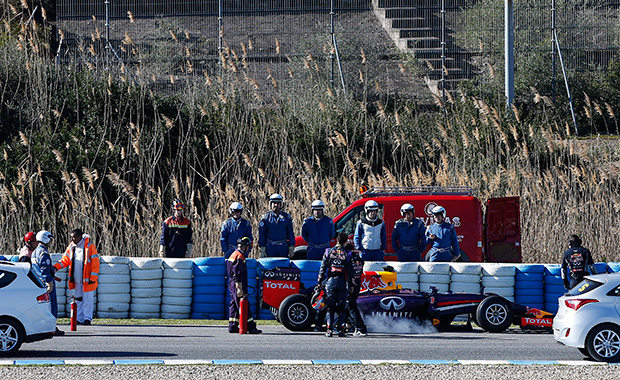Has the Red Bull era been ended by the new formula? That was the intriguing possibility to emerge from the first bout of testing of the new generation F1 turbo hybrids.
The reigning champions barely managed to string together more than 20 slow laps in three days at Jerez thanks to serious reliability problems with Renault Sport’s power unit. With only two more tests to go before the season starts, are we about to witness a season of Mercedes-powered domination? Well maybe, but don’t bet heavily on it.
The Renault’s problems – apparent also in the Toro Rosso and Caterham (Lotus, the other Renault-powered team, didn’t make the test) – centre around the energy storage (i.e. battery) part of the system and are believed to be mainly related to vibration.
By contrast, the Mercedes and Ferrari power units allowed their teams to rack up hundreds of miles, each like lap like gold dust with so much to learn about the new technology of the power units and the traits of the heavily reconfigured cars.
The intriguing question is whether this is just a glitch from Renault or the early part of a very painful learning curve. “We believed our initial configuration was a robust start point for track use,” said Renault Sport’s Rob White, “but it has not proved to be the case. We have done substantial dyno running in a similar configuration with few issues.
“We now know that the differences between dyno and car are bigger than we expected, with the consequence that our initial impressions were incomplete and imperfect.” Mercedes’ running at Jerez gave the impression of a deeper preparation.
Mercedes prepared for challenges
When the team effectively gave up on its 2012 car part-way through that season, it was in order to divert resource towards the 2014 car. Two years in the planning, the W05’s initial concept was abandoned early; the team realised as it dug down into the requirements of the new power units that many of the assumptions were wrong – in terms of the impact they had on the rest of the car.
“If you start too late you get committed down a route whether it’s right or wrong,” says the team’s recently ex-team principal Ross Brawn. “With such different car concepts you want to be able to take a few different routes and then be able to choose – and that’s what we did.
“One of the big challenges with these cars is the cooling concept – which has to be hand in hand with the engine concept. For example: what charge air temperature are you going to try and target? Because of the fuel flow restriction, it doesn’t follow – like it did in the old days – that the cooler you keep the charge flow the more power you generate.
“Because you’ve got fuel flow limits the optimum air charge temp is now much more linked to the maximum fuel flow; it’s quite a complex, multi-dimensional problem and solution and no longer ‘let’s charge the air as soon as we can to get more horsepower’.”
For the last few months Ross had the team drilled at Brackley to run the new engine and its associated systems on the dyno there exactly as if it were a Grand Prix weekend, with practices one, two and three, qualifying and race – and the same amount of time between running. “That brought to light an enormous number of problems we wouldn’t otherwise have found,” he explains.
Jerez test top 10 times
1 Kevin Magnussen, McLaren-Mercedes 1min 23.276sec
2 Felipe Massa, Williams-Mercedes 1min 23.700sec
3 Lewis Hamilton, Mercedes 1min 23.952sec
4 Jenson Button, McLaren-Mercedes 1min 24.165sec
5 Kimi Räikkönen, Ferrari 1min 24.812sec
6 Valtteri Bottas, Williams-Mercedes 1min 25.344sec
7 Fernando Alonso, Ferrari 1min 25.495sec
8 Nico Rosberg, Mercedes 1min 25.588sec
9 Nico Hülkenberg, Force India-Mercedes 1min 26.096sec
10 Sergio Pérez, Force India-Mercedes 1min 28.376sec
“I think the work we did to get the project started early and the problems we had on the dyno – in developing a drivetrain in as representative a condition as possible to that we get on the track – told us that turning up at the track without doing all that would be a nightmare.
“I remember the problems we had when we put an engine and gearbox and all the other gubbins on a dyno and tried to get the whole thing to run properly – all the energy recovery systems and all the rest. The first few months were a nightmare. Some teams are having problems now: but at what point on that curve are they?
“If you approached it like the old days – just take the engine, plug it in, stick a gearbox on the back of it and stick it on the track – you’ll have a nightmare. Heat, installation, the dynamic coupling of everything – it’s fascinating in many ways. But God help those who have not been on the dyno in representative conditions.”
After several seasons of engine freeze, is this new formula about to more heavily reward those like Mercedes and Ferrari for their ability to integrate chassis and engine within the structure of the organisation?
Is the Red Bull model of simply being supplied engines by a separate entity a much bigger disadvantage than in the engine freeze days? It’s very early days – and who would be all that surprised if the RB10 with its re-fettled Renault turns up at the next test and blitzes everyone? – but it’s a thought isn’t it?






